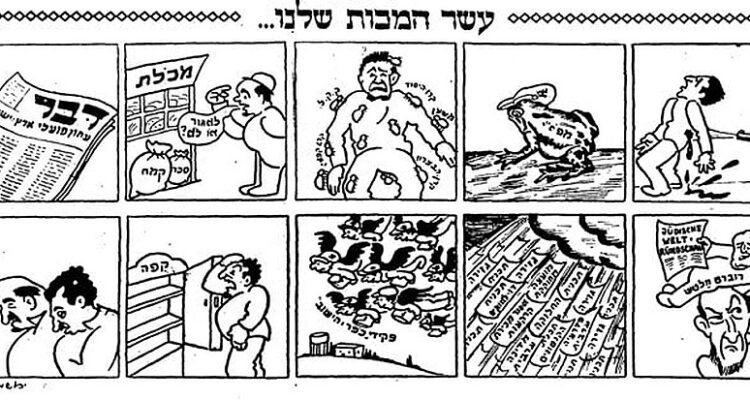A fascinating cartoon that appeared in the Hebrew press in British Mandatory Palestine just before Passover in 1939 reminds us that fierce quarreling long has been a feature of Jewish life in the Holy Land.
By Rafael Medoff, Jewish Journal
The current turmoil in Israel over judicial reform may be unsettling to many outside observers, but a fascinating cartoon that appeared in the Hebrew press in British Mandatory Palestine just before Passover in 1939 reminds us that fierce quarreling long has been a feature of Jewish life in the Holy Land.
The cartoon was the handiwork of Yehoshua Adari (1911-1966), staff cartoonist for HaMashkif, the daily newspaper of the nationalist Revisionist Zionist movement, which was headed by Ze’ev Jabotinsky.
Titled “Our Ten Plagues” and appearing in the newspaper’s Passover holiday edition, Adari’s cartoon spotlighted ten problems afflicting Palestine Jewry — at least according to the perspective of the cartoonist and his editors.
The first plague was violence. The shooting depicted in the cartoon probably referred to a recent spate of Palestinian Arab terrorist attacks. Six days earlier, a teenage German Jewish immigrant who was serving as a police officer in Haifa was shot to death while escorting a delivery of mail. The day after that, terrorists shot and killed a rabbi in Tiberias and seriously wounded a telephone worker in Jerusalem.
The second and third plagues used images commonly associated with the biblical plagues. The frog, wearing a worker’s cap, was labeled with the acronym of the Palestine Communist Party, an extremist movement that opposed Zionism and defended Arab violence. The lice in the third plague bore the names of Palestine Jewish fundraising bodies that were controlled by the Labor Zionists, the arch-rivals of Jabotinsky’s Revisionists.
The fourth plague alluded to the frequently fluctuating prices of basic foods. A typical consumer was shown looking at scans of sugar and flour in a grocery store, and asking himself, “To hoard or not to hoard?”
Plague number five was the Labor Zionists’ daily newspaper, Davar. Articles and editorials in Davar frequently denounced the Revisionists and even compared Jabotinsky to Adolf Hitler.
Davar earned particular enmity among Jabotinsky’s followers when it led the campaign to falsely accuse the Revisionists of assassinating Labor Zionist official Chaim Arlosoroff in 1933.
The sixth plague was Robert Weltsch, a prominent German-born Jewish journalist who was a frequent thorn in the Revisionists’ side. Weltsch advocated creating a binational Arab-Jewish Palestine instead of a Jewish state.
The cartoon’s seventh plague was the array of British decrees, peace plans, and other proposals that were so numerous that they seemed like a torrential downpour. Among those named were “Binational proposal,” “Ban on land sales [to Jews],” “Partition, “Arab state,” “Cantons proposal,” and “Arab Federation.”
Plague number eight was the “Kofer HaYishuv,” a tax that the Labor Zionist-controlled Jewish National Council imposed on Palestine’s Jews in 1939. The Revisionists saw it as an unfair attempt by the Laborites to expand their domination of Palestinian Jewish society — hence the depiction of tax collectors swooping down on the community.
The ninth plague might be described as the general economic stress afflicting Palestine Jewry — an ordinary citizen was shown opening his safe and finding it empty.
The tenth and final plague, in the eyes of the Revisionist Zionists, was the Labor-dominated Zionist leadership — from left to right, Berl Katznelson, Chaim Weizmann, and Moshe Shertok — regarded by the Jabotinskyites as bearing responsibility for the woes of the yishuv.
Arab terrorism, social policy controversies, intense political rivalries, high taxes and other economic turmoil — old problems with new faces, it seems, in every generation.
Dr. Medoff is the author of more than 20 books about Jewish history and Zionism, including The Historical Dictionary of Zionism [with Chaim I. Waxman].





